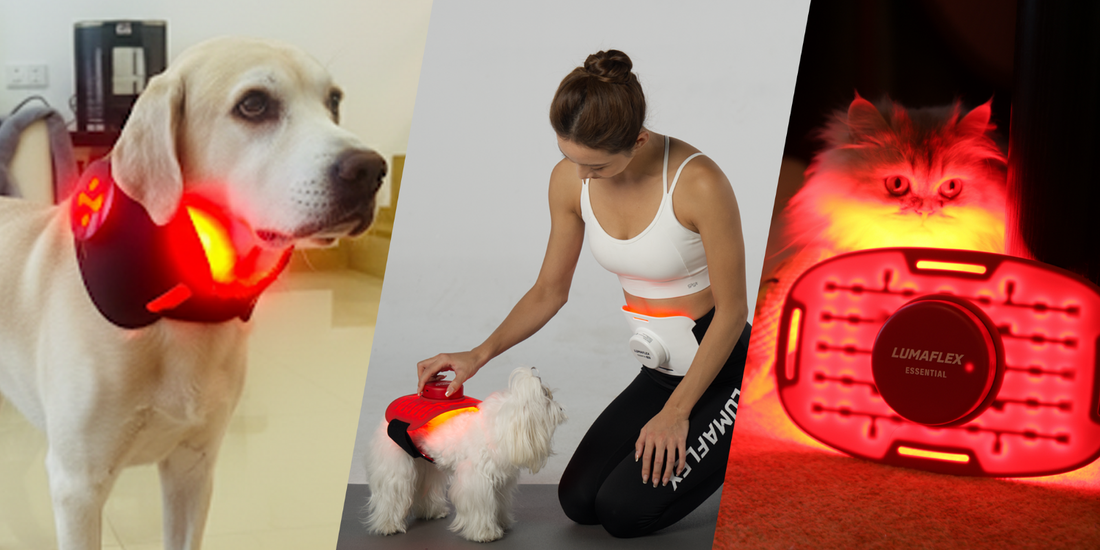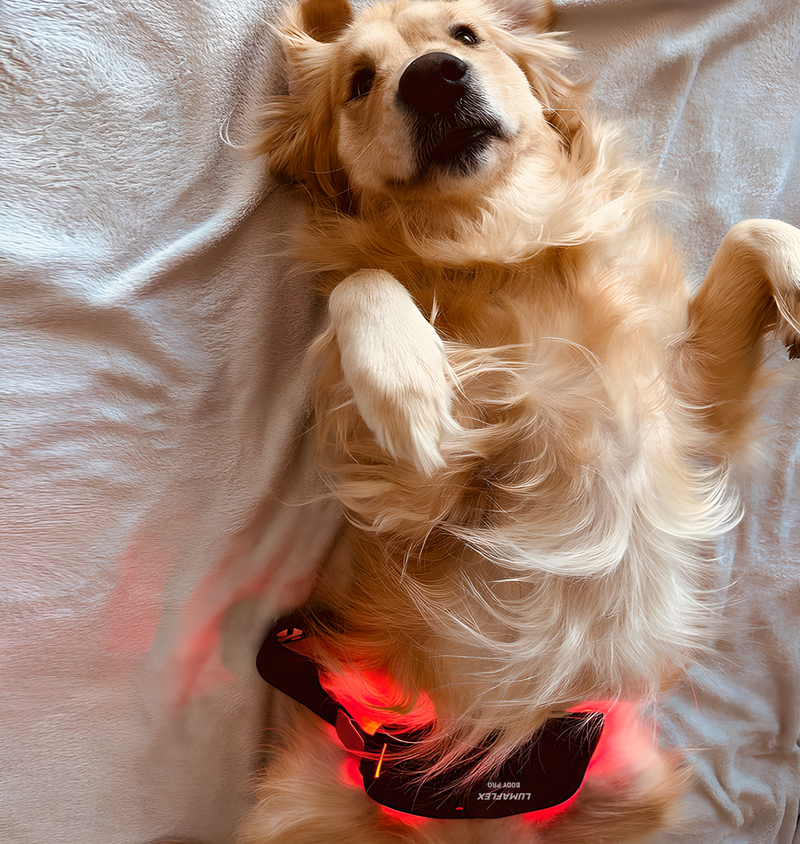
Red Light Therapy for Dogs: Top Case Studies on Pain Relief, Healing, and Cognitive Health
Key Takeaways: Red Light Therapy for Dogs
Effective Pain Relief:
- RLT reduces inflammation and soothes chronic joint and muscle pain.
- Studies show dogs with arthritis or post-surgical discomfort experience improved mobility and reduced reliance on NSAIDs.
Accelerates Wound Healing & Infection Recovery
- RLT promotes tissue repair, collagen production, and faster wound closure.
- Research demonstrates reduced bacterial infection and quicker recovery from skin injuries and post-surgical wounds.
Supports Cognitive Health
- Emerging studies indicate red and near-infrared light can improve brain function in aging dogs.
- Benefits may include enhanced memory, alertness, and reduced anxiety.
Boosts Circulation and Cellular Function
- Light therapy enhances blood flow, delivering oxygen and nutrients more efficiently.
- This supports overall tissue repair, immune response, and energy metabolism at the cellular level.
Non-Invasive & Safe
- RLT is drug-free, painless, and generally well-tolerated by dogs.
- Can be used alongside traditional veterinary treatments without adverse side effects.
Reduces Medication Dependence
- Case studies show dogs treated with RLT often require fewer pharmaceuticals for pain or inflammation management.
- Offers a natural complement to standard care.
Versatile Applications
- Effective for arthritis, neuropathic pain, post-surgical recovery, chronic wounds, and even cognitive decline.
Can be applied at home with safe, veterinary-approved devices or in professional clinic settings.
Introduction
Over the past decade, Red Light Therapy—also known as Photobiomodulation (PBM)—has emerged as a groundbreaking, non-invasive treatment for pets. Originally developed for human therapeutic applications, PBM is now being used to improve canine health, from reducing chronic pain and inflammation to accelerating wound healing and supporting cognitive function. With its safety profile and growing body of clinical evidence, this technology is rapidly becoming a valuable tool in veterinary care.
Case Studies Background

Pet owners often face challenges when their pets are dealing with chronic conditions, injuries, or age-related issues.
From slow-healing scars to joint pain, cognitive decline, and persistent inflammation, these problems can impact a pet’s quality of life—and make caregiving stressful.
Emerging research on Photobiomodulation (PBM), also known as red and near-infrared light therapy, highlights how this non-invasive treatment can help address many of these common concerns:
1. Healing Scars & Intervertebral Disc Disease
Pet owners often struggle with slow-healing scars and mobility issues in pets, especially after surgery or conditions like intervertebral disc disease. A common problem is that scars in animals tend to remain inflamed, stiff, and resistant to healing, which delays recovery and limits mobility. The study published in the Journal of Photodiagnosis and Photodynamic Therapy found that Photobiomodulation (PBM) therapy helped accelerate tissue repair, reduce inflammation, and improve movement in dogs with scarring and disc disease.
- Study: Journal of Photodiagnosis and Photodynamic Therapy
- Findings: PBM promoted tissue repair, reduced inflammation, and improved mobility in dogs suffering from scarring and intervertebral disc disease.
2. Resolving Chronic Gingivostomatitis
Pet owners of dogs with chronic gingivostomatitis often face ongoing challenges—persistent oral inflammation, painful ulcers, difficulty eating, and slow healing. The common problem is that conventional treatments can only partially manage symptoms, leaving pets uncomfortable and owners frustrated. A study in the Journal of Photodiagnosis and Photodynamic Therapy showed that Photobiomodulation (PBM) therapy provided significant relief by reducing oral inflammation, accelerating tissue healing, and easing discomfort in affected dogs.
- Study: Journal of Photodiagnosis and Photodynamic Therapy
- Findings: Dogs experienced significant relief from chronic oral inflammation, faster tissue healing, and reduced discomfort.
3. Improving Cognitive Health
Pet owners of aging dogs often notice signs of cognitive decline—slower responsiveness, reduced alertness, and changes in memory or behavior. These issues can be frustrating and concerning, as they affect a pet’s quality of life. The 2024 study in the Open Veterinary Journal, USA found that Photobiomodulation (PBM) therapy helped improve alertness, responsiveness, and overall cognitive function in aging dogs, highlighting its potential to support long-term brain health and maintain mental sharpness.
- Study: Open Veterinary Journal, USA, 2024
- Findings: PBM improved alertness, responsiveness, and overall cognitive function in aging dogs, demonstrating potential for maintaining brain health.
4. Improving Osteoarthritis & Mobility
Pet owners of dogs with osteoarthritis frequently face challenges like stiffness, limited mobility, and difficulty performing everyday activities, which can impact both the pet’s quality of life and the owner’s ability to care for them. A common problem is that traditional treatments often focus on managing pain rather than restoring joint function. The study in Veterinary Medicine and Science found that Photobiomodulation (PBM) therapy helped dogs regain joint flexibility, reduce stiffness, and improve mobility, demonstrating a safe, non-invasive option for supporting long-term joint health.
- Study: Veterinary Medicine and Science
- Findings: Dogs with osteoarthritis regained joint flexibility and reduced stiffness, highlighting PBM as a non-invasive option for chronic joint conditions.
5. Reducing Pain & Bilateral Hip Arthritis
Pet owners of dogs with bilateral hip arthritis often struggle to see their pets in pain—reluctant to move, experiencing stiffness, or avoiding activity altogether. A common challenge is that conventional pain management may not fully restore comfort or encourage normal activity. The 2024 study in the Open Veterinary Journal, USA demonstrated that Photobiomodulation (PBM) therapy reduced pain levels, increased activity, and improved mobility, enhancing both the pet’s quality of life and the ease of daily care for owners.
- Study: Open Veterinary Journal, USA, 2024
- Findings: Dogs reported decreased pain levels and increased activity after PBM treatments, improving overall quality of life..
6. Reducing Pain and NSAID Requirements
Pet owners managing dogs with chronic pain often rely on NSAIDs to control discomfort, but long-term use can pose health risks such as gastrointestinal, kidney, or liver issues. The 2018 study in the Canadian Veterinary Journal found that Photobiomodulation (PBM) therapy reduced the need for NSAIDs by effectively alleviating pain, offering a safer, non-invasive alternative for long-term pain management and improving the pet’s overall comfort and well-being.
- Study: Canadian Veterinary Journal, 2018
- Findings: PBM reduced reliance on NSAIDs for pain management, offering a safer long-term solution for chronic pain..
7. Reducing Bacterial Infection & Improving Wound Healing
Pet owners often face frustration when their pets have slow-healing wounds, which can become infected and lead to extended recovery times or additional complications. The 2021 study in the Journal of Lasers in Medical Sciences showed that Photobiomodulation (PBM) therapy accelerated wound closure and reduced bacterial infection, helping pets recover faster, experience less discomfort, and minimize post-injury complications.
- Study: Journal of Lasers in Medical Sciences, 2021
- Findings: PBM accelerated wound healing and minimized bacterial infection, leading to faster recovery times and less post-injury discomfort.
Dogs (& Cats) Case Studies on Photobiomodulation Therapy
Conclusion
These studies collectively underscore the transformative potential of Red Light Therapy for canine health. PBM not only alleviates pain and improves mobility, but also supports wound healing, cognitive function, and overall quality of life. By offering a non-invasive, drug-free approach, PBM is redefining veterinary care for dogs, giving pet owners a safe and effective way to support their companions’ health. As research continues to grow, Red Light Therapy is poised to become a standard tool in veterinary wellness, helping dogs live longer, healthier, and more comfortable lives.





